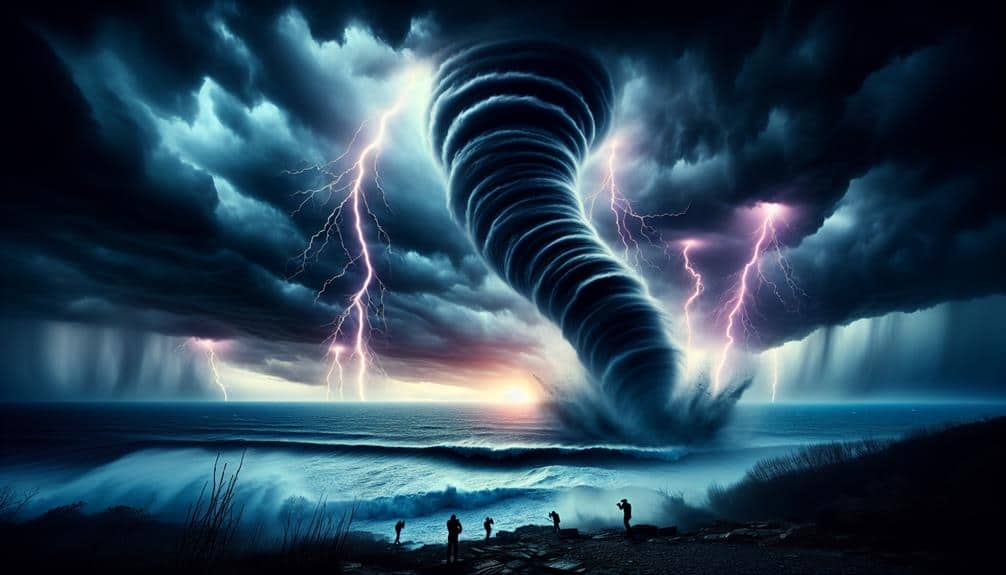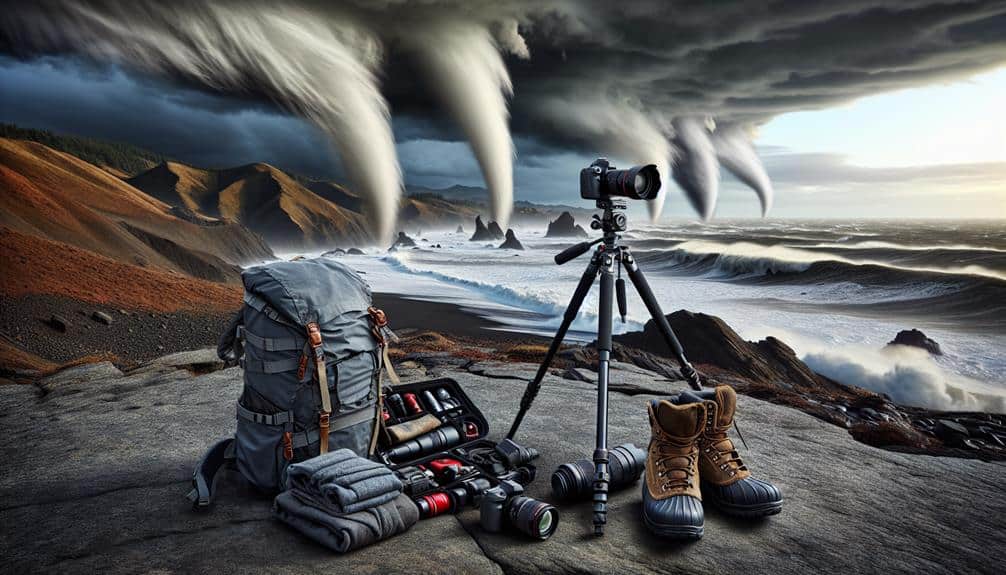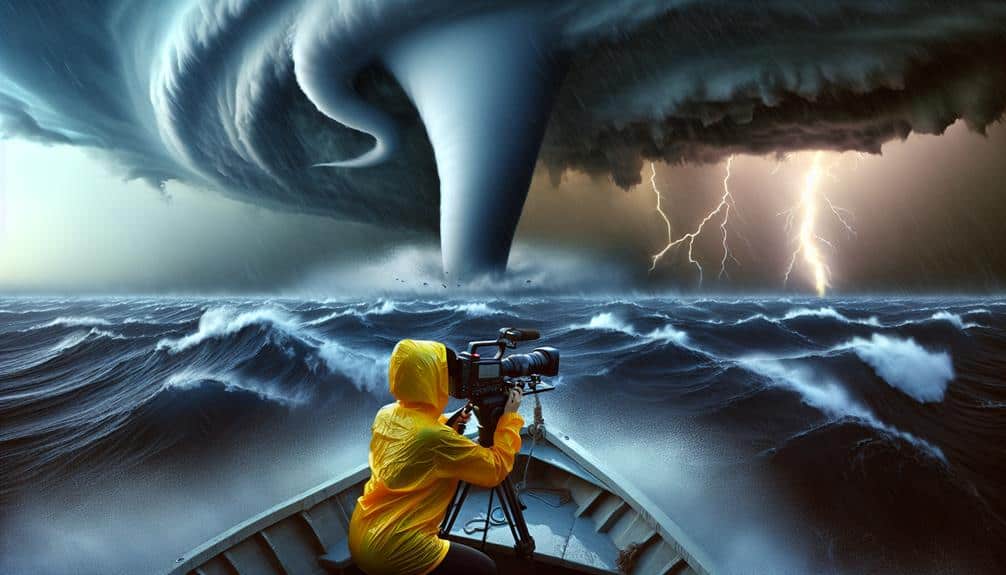We explore waterspouts by combining advanced technology and strategic planning. Fair-weather and tornadic waterspouts present unique challenges, forming rapidly over warm waters under distinct conditions. With essential gear like weather radar systems, GPS, and communication devices, we stay safe and effective. Locations like the Florida Keys and Great Lakes offer prime waterspout chasing opportunities. Capturing these phenomena on camera requires skillful use of tripods, wide-angle lenses, and careful assessment of lighting and weather conditions. Our memorable encounters teach us the importance of respect for nature's forces and preparation. Curious about our most thrilling adventures? Join us on this journey.
Key Points
- Storm chasers highlight the rapid formation and unpredictable movement of waterspouts, emphasizing the need for constant vigilance.
- Fair-weather and tornadic waterspouts differ in formation conditions and destructiveness, crucial knowledge for safe storm chasing.
- Essential gear like weather radar systems, GPS units, and emergency communication devices ensure successful and safe waterspout chasing.
- Popular waterspout chasing locations include the Gulf of Mexico, Florida Keys, Great Lakes, and the Mediterranean.
The Science of Waterspouts
Let's explore the complex meteorological mechanisms that give rise to waterspouts. Waterspout formation hinges on specific meteorological factors such as warm water surfaces, humid air, and atmospheric instability. When warm, moist air ascends and interacts with cooler air aloft, conditions become ideal for these fascinating phenomena. The convergence of wind at the surface forms a rotating column, which, when stretched vertically, evolves into a waterspout.
We can classify waterspouts into two primary types: fair-weather waterspouts and tornadic waterspouts. Fair-weather waterspouts typically form along the dark, flat bases of developing cumulus clouds. Their formation doesn't require extreme weather conditions, making them more common yet less intense.
In contrast, tornadic waterspouts arise from severe thunderstorms and share many characteristics with land-based tornadoes, including higher wind speeds and greater destructive potential. Understanding the unique characteristics of each type is essential for storm chasers. Fair-weather waterspouts, with their slender, elegant appearance, contrast sharply with the more formidable tornadic waterspouts.
Both types, however, embody the raw power and beauty of nature, captivating those of us who revel in the freedom of chasing storms.
Essential Gear for Storm Chasers
Equipped with the knowledge of waterspout formation, we now focus on the essential gear that guarantees both safety and success for storm chasers. To navigate the unpredictable and often harsh environments, we rely on a meticulously curated arsenal of tools and gadgets.
First and foremost, technology devices are our eyes and ears in the storm. High-resolution cameras, drones, and weather radar systems allow us to capture real-time data and stunning visuals. These devices help us predict waterspout patterns and movements with remarkable accuracy.
Next, precise guidance tools are essential. GPS units and digital maps ensure we can chart safe and efficient routes. These tools are critical for avoiding hazardous zones and optimizing our position for observation and documentation.
Lastly, communication devices are essential for coordination and emergency situations:
- Satellite phones keep us connected even when cellular networks fail.
- Two-way radios facilitate immediate communication within the team.
- Emergency beacons provide a lifeline if we find ourselves in perilous conditions.
Safety Tips for Waterspout Chasing
When chasing waterspouts, ensuring safety amidst unpredictable and hazardous conditions is paramount. First and foremost, boat safety must be prioritized. This involves maintaining vessels in top condition through regular checks of the engine, hull integrity, and navigation systems. Equipping boats with life vests, fire extinguishers, and first aid kits is essential. Additionally, having a reliable GPS and marine radio enhances navigation capabilities and keeps communication channels open.
Emergency response protocols play a critical role in ensuring safety. Developing a comprehensive emergency plan with predefined actions for different scenarios is crucial. Regular emergency drills help familiarize everyone onboard with their roles and enable swift action during crises. It is also important to keep contact information for local coast guards and emergency services easily accessible.
Constant monitoring of weather patterns is vital for safe waterspout chasing. Utilizing advanced meteorological tools and apps can provide real-time updates and help in making informed decisions. By adopting a safety-first mindset and following these guidelines, individuals can pursue the exhilarating activity of waterspout chasing while safeguarding their well-being.
Memorable Waterspout Encounters
We've witnessed some unforgettable waterspout encounters characterized by close calls and unexpected formations. These experiences highlight the unpredictable nature of waterspouts and underscore the importance of vigilance.
Let's analyze a few notable instances to understand their dynamics and implications.
Close Call Experiences
Amidst the unpredictable nature of waterspouts, several close encounters have provided valuable insights into their behavior and risks. These experiences not only deliver an adrenaline rush but also contribute to our growing collection of survival stories. Close encounters with waterspouts can offer essential observational data, but they also underscore the inherent dangers involved.
Analyzing our close calls has revealed several key patterns:
- Rapid Development: Waterspouts can form with little warning, escalating from a calm sea to a full vortex within minutes. This rapid development demands constant watchfulness.
- Erratic Movement: The path of a waterspout is often unpredictable. We've witnessed sudden shifts in direction that could easily ensnare an unprepared observer.
- Intensity Variations: Not all waterspouts are created equal. Some dissipate quickly, while others gain strength, posing significant risks to nearby vessels and structures.
Surviving these encounters requires a blend of preparation and quick thinking. We always make sure our equipment is ready for immediate action, and we never underestimate the power of nature. Each close call reinforces our respect for these phenomena and the importance of meticulous planning.
Our survival stories aren't just tales of adventure—they're lessons in resilience and the pursuit of freedom in understanding nature's forces.
Unexpected Waterspout Formations
In our years of observation, we've documented numerous instances where waterspouts formed unexpectedly, leaving an indelible mark on our understanding of these phenomena. These rare sightings often occur in conditions not typically associated with extreme weather.
One memorable encounter involved a sudden waterspout formation in clear skies, a scenario that defied conventional meteorological wisdom. The unpredictable formations of these water tornadoes challenge our predictive models and underscore the complexity of atmospheric dynamics.
While tracking a storm system off the coast, we witnessed a waterspout materialize without the usual precursors—no thunderstorm activity, minimal wind shear, and stable atmospheric conditions. This event highlighted the necessity of continuous monitoring and advanced detection technologies to identify such anomalies. The waterspout's rapid development and dissipation exemplify the transient nature of these phenomena and the potential risks they pose to marine navigation.
Another significant observation occurred in the Gulf of Mexico, where multiple waterspouts emerged simultaneously, creating a rare sighting of coexisting vortices. These events demonstrate the variability and intricacy of waterspout formations, emphasizing the importance of flexibility and adaptability in our approach to storm chasing.
Best Locations for Waterspout Chasing

Let's identify the best coastal hotspot destinations for waterspout chasing, considering the influence of seasonal weather patterns.
We'll also outline essential safety precautions to guarantee our endeavors remain secure.
Coastal Hotspot Destinations
Several coastal regions around the world offer ideal conditions for observing and studying waterspouts. As storm chasers, we're always in search of hidden gems that provide unique perspectives.
Here are some of the best locations:
- Florida Keys, USA: Known for its warm waters and frequent thunderstorms, the Florida Keys offer a perfect blend of accessibility and frequency of waterspouts. The region's geography and climate make it a hotspot for both tornadic and fair-weather waterspouts.
- Gulf of Mexico: The Gulf's expansive and relatively shallow waters create an excellent environment for waterspout formation. This area is particularly active during the late summer months, providing numerous opportunities for observation.
- Adriatic Sea, Italy: This lesser-known location is a hidden gem for waterspout enthusiasts. The unique combination of mountainous terrain and warm sea temperatures around the Adriatic coast contributes to frequent and visually stunning waterspouts.
These destinations not only offer prime conditions for waterspout chasing but also provide diverse landscapes and weather patterns that enrich our understanding of these phenomena. Each location gives us the freedom to explore and capture the awe-inspiring beauty of waterspouts from unique perspectives.
Seasonal Weather Patterns
Weather patterns significantly influence the best times and locations for waterspout chasing, making it crucial to comprehend seasonal variations for the finest observation. Our focus primarily shifts during the hurricane season, which typically spans from June to November in the Atlantic and Eastern Pacific regions. This period heightens the likelihood of encountering waterspouts due to the increased frequency of tropical storms and associated weather phenomena.
Geographically, the Florida Keys are a prime location during this season. The convergence of warm ocean waters and atmospheric instability creates a fertile environment for waterspout formation. The Great Lakes region, particularly during late summer to early fall, also presents strong opportunities, as temperature differentials between the lakes and the surrounding air contribute to waterspout activity.
In the Mediterranean, late summer and early autumn are ideal for waterspout chasing, especially along the coasts of Italy, Greece, and Turkey. Here, the interaction between warm sea surfaces and cool air masses enhances the potential for waterspouts.
Understanding these seasonal and geographic patterns allows us to strategically plan our chases, maximizing our chances of witnessing these mesmerizing weather phenomena. This analytical approach guarantees we're always in the right place at the right time.
Safety Precautions Essentials
Safeguarding safety while chasing waterspouts necessitates a thorough understanding of both the environmental conditions and the inherent risks associated with these powerful phenomena. Our primary objective is to balance the thrill of the chase with meticulous risk assessment and emergency response readiness.
When selecting the best locations for waterspout chasing, we need to ponder several critical factors:
- Accessibility: We must guarantee that our chosen location is easily accessible for both arrival and evacuation. Remote areas with challenging terrain can complicate emergency response efforts.
- Visibility: Clear lines of sight are crucial. Coastal areas with minimal obstructions allow us to monitor the waterspout's formation and movement, reducing the likelihood of being caught off-guard.
- Communication: Reliable communication channels are indispensable. Locations with strong mobile network coverage or satellite communication options ensure we can stay informed about weather updates and coordinate emergency responses if necessary.
Capturing Waterspouts on Camera
Capturing waterspouts on camera requires precise timing, best positioning, and an understanding of their formation patterns. To achieve the perfect shot, we must first master various camera techniques. Using a tripod guarantees stability, while experimenting with unique angles can transform a standard image into a compelling visual narrative. Wide-angle lenses allow us to capture the entire scene, emphasizing the waterspout's grandeur against the horizon.
Assessing weather conditions is essential. We monitor wind patterns, temperature changes, and humidity levels to anticipate waterspout formation. Ideal lighting significantly improves image quality. Early morning and late afternoon provide the best natural light, with the sun low on the horizon, casting dramatic shadows and highlighting the waterspout's structure.
Positioning is equally important. We often place ourselves at a safe distance, making sure we're not in the path of the storm yet close enough to capture the details. Utilizing a remote shutter release can prevent camera shake, especially in windy conditions. We also consider the background, aiming for a clear, uninterrupted view to avoid distractions.
Frequently Asked Questions
What Motivates Storm Chasers to Pursue Waterspouts Despite the Risks?
We're motivated by the thrill-seeking nature of storm chasing. The danger fuels our excitement and adrenaline. The pursuit of waterspouts offers a unique challenge and freedom that's hard to find elsewhere.
How Do Storm Chasers Prepare Mentally for Their Expeditions?
Like athletes facing a marathon, we build mental fortitude and preparation through relentless focus and resilience. Each expedition demands we sharpen our minds, anticipate challenges, and embrace uncertainty, ensuring we're ready for whatever nature throws our way.
What Are the Main Challenges Faced When Chasing Waterspouts?
When chasing waterspouts, we encounter unpredictable weather patterns and must prioritize safety precautions. Our equipment needs are essential, and we deploy precise navigation strategies to guarantee we capture data while avoiding hazardous conditions.
How Do Storm Chasers Communicate and Coordinate With Each Other?
Like a well-coordinated orchestra, we storm chasers rely on collaborative efforts and advanced weather tracking tools. Real-time communication through radios and apps guarantees our safety and precision, allowing us to freely pursue nature's most elusive phenomena.
What Are the Most Common Misconceptions About Storm Chasing Waterspouts?
The most common misconceptions about storm chasing waterspouts involve myth debunking and scientific facts. We prioritize safety precautions and use equipment essentials, ensuring informed decisions. Understanding risks and realities is important for our freedom and survival.


